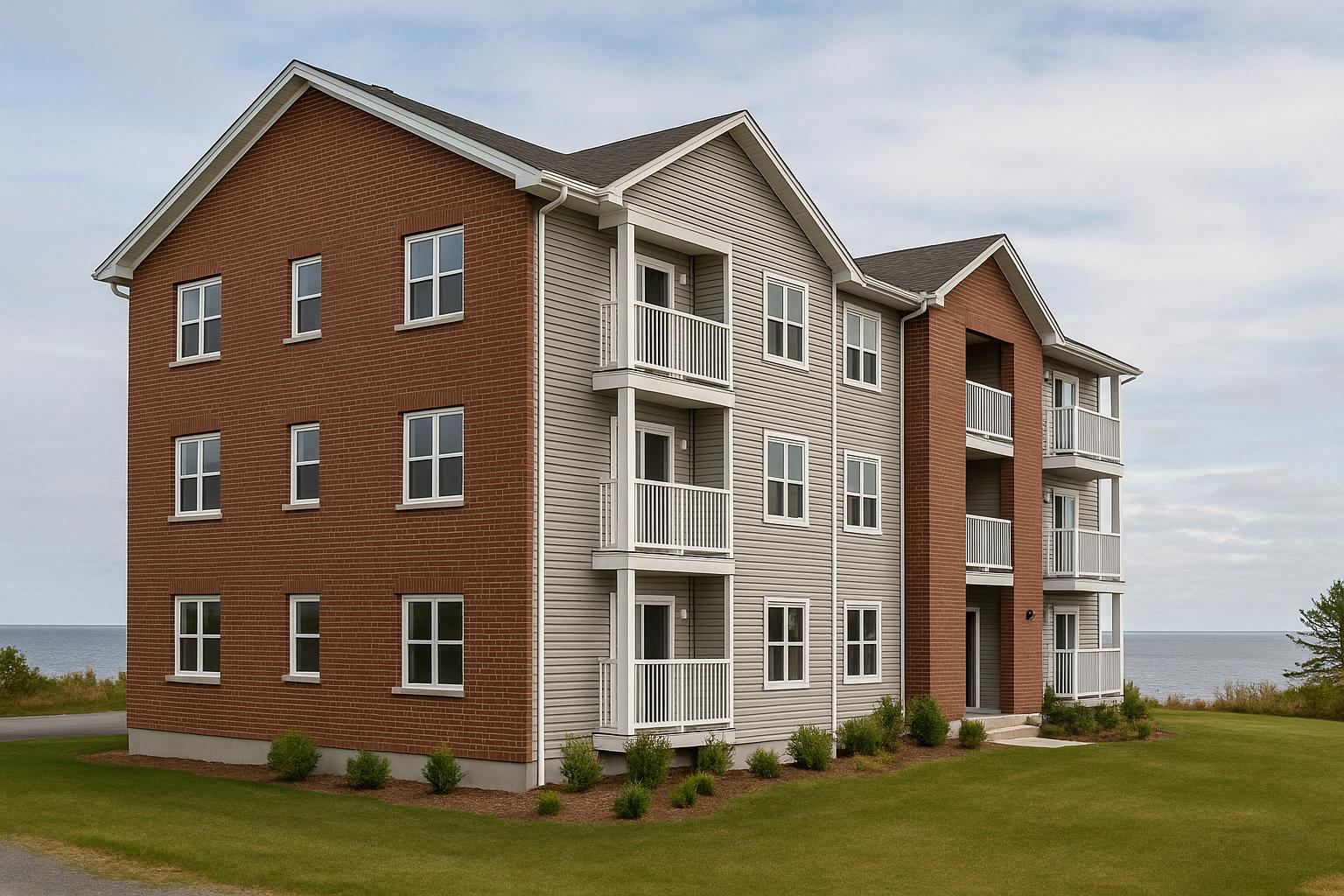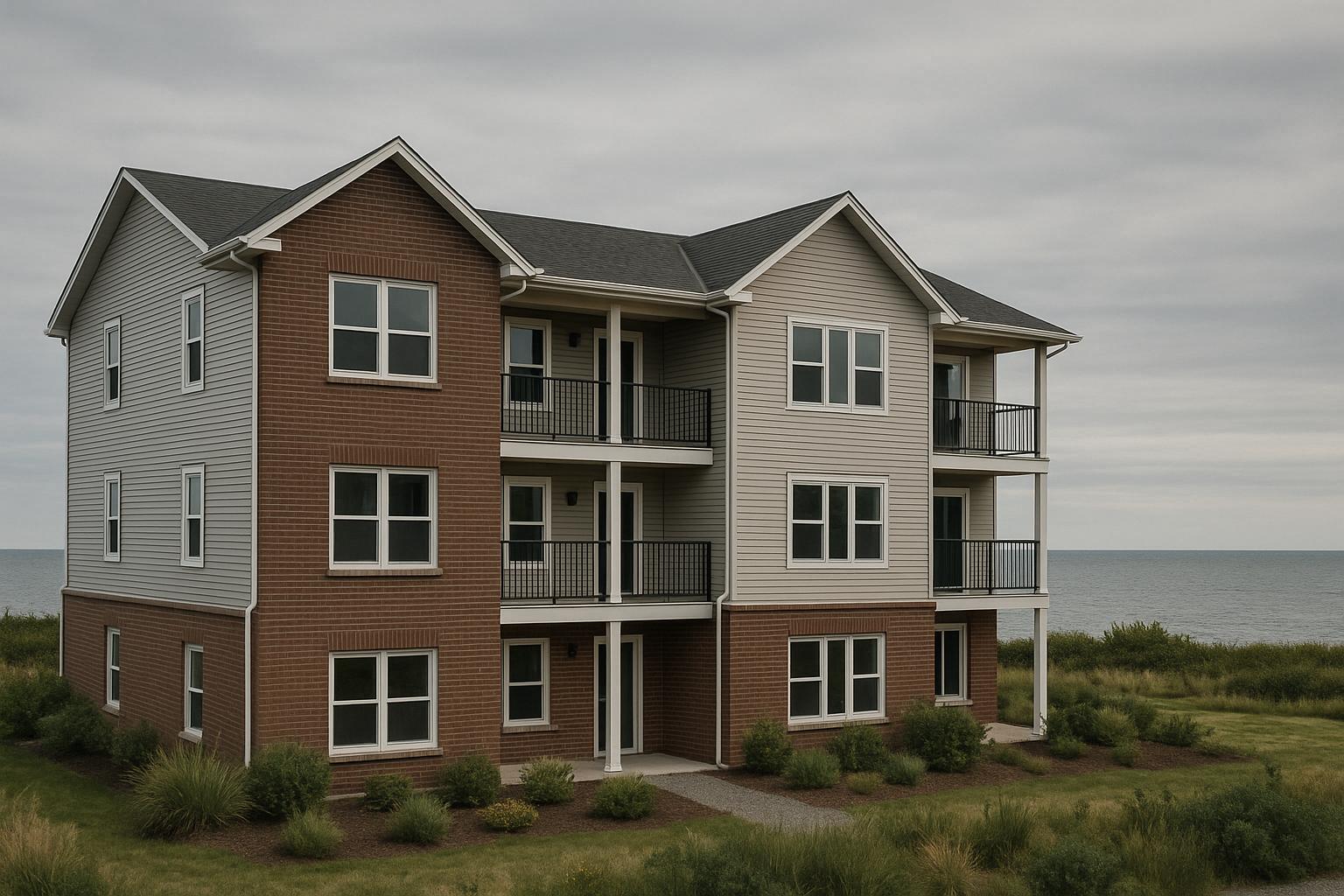Zero-parking apartment developments are reshaping Halifax's rental market by reducing construction costs and increasing housing density. These projects thrive in transit-rich, walkable areas, catering to renters who prioritize convenience over car ownership. Recent zoning changes in Halifax have made such developments more feasible, especially in neighbourhoods with strong public transit and local amenities. Here's a quick look at the streets leading this trend:
- Spring Garden Road: Potential for zero-parking projects, but further analysis of transit access and zoning is needed.
- Gottingen Street: High demand among young professionals and students, supported by strong transit links and updated zoning.
- Quinpool Road: Affordable rents, multiple transit routes, and walkable amenities make this a prime area for car-free living.
- Peninsula South: New zoning allows for taller buildings and higher density near universities, attracting students and professionals.
- Victoria Road: Proposed zoning changes under the Housing Accelerator Fund could make this area a hotspot for zero-parking developments.
These locations combine cost savings for developers with high demand from tenants seeking transit-friendly, walkable lifestyles. However, not all tenants may prefer car-free living, making it critical for developers to align projects with local needs.
1. Spring Garden Road
Spring Garden Road stands out as a possible location for developing apartments without dedicated parking. However, there’s limited verified information on key factors like transit accessibility, zoning changes, or existing zero-parking initiatives in the area. For now, property owners and developers should consult municipal planning documents and study market trends to make informed decisions. This initial overview provides a starting point for exploring other streets with more defined project opportunities.
2. Gottingen Street
Gottingen Street stands out as a prime spot for zero-parking developments. Nestled in Halifax's North and West End, this area boasts a near-zero vacancy rate, making it highly attractive for developers [1]. The street appeals to two major tenant groups: young professionals working downtown and students attending nearby Dalhousie and Saint Mary's universities. Both groups are drawn to the convenience of car-free living, which is reflected in the competitive rental prices.
Rents for one-bedroom apartments in the area start at over $1,600, highlighting the premium tenants place on walkability and easy access to transit. With Halifax grappling with a housing shortfall of approximately 20,000 units in 2023 [1], developers who skip the expense of parking infrastructure can gain a significant edge in the market.
The area’s excellent transit connections link residents to major job hubs and educational institutions, perfectly aligning with the preferences of those who prioritize convenience over car ownership.
Recent changes in zoning regulations further enhance the feasibility of such projects. In transit-friendly neighbourhoods like Gottingen Street, new rules now allow for 4–8 units per lot, encouraging higher-density, car-free living [1].
When you combine solid rental demand, supportive zoning policies, and a tenant base that embraces alternative transportation, Gottingen Street emerges as an ideal candidate for parking-free apartment developments.
3. Quinpool Road
Quinpool Road is a key corridor in Halifax, connecting the heart of the peninsula to the west end. This busy stretch has become a hotspot for zero-parking apartment developments, offering unique opportunities to increase density along a major transit route.
Affordable rents for one-bedroom units make this area particularly appealing to young professionals, university students, and healthcare workers. These groups value easy access to public transit and the ability to navigate the neighbourhood on foot. Quinpool Road’s extensive transit network plays a big role in supporting these preferences.
The area is served by multiple bus routes that provide direct connections to downtown Halifax, universities, and major job hubs. During peak hours, frequent service ensures that public transit remains a reliable option for residents.
Quinpool Road also stands out for its pedestrian-friendly design. Essential services like grocery stores, pharmacies, and restaurants are all within walking distance, making it easy to live without a car.
Recent zoning changes have allowed for higher-density housing by increasing the number of units permitted on existing lots. These updates offer property owners a chance to boost rental income while skipping the costs tied to parking requirements.
With its well-established infrastructure and zoning that encourages transit-oriented growth, Quinpool Road is an attractive option for property owners looking to tap into Halifax’s demand for higher-density living.
4. Peninsula South
Peninsula South has become a prime spot for zero-parking apartment developments. Thanks to recent zoning changes, minimum parking requirements have been eliminated, and areas near Saint Mary’s and Dalhousie universities have been reclassified as Higher-Order Residential 2 (HR-2). This allows for buildings up to nine storeys, creating opportunities to add more rental units on existing lots [2]. By removing the need for parking spaces, developers can now use that freed-up space to increase rental capacity. These zoning updates align perfectly with the area’s well-established transit system.
Being close to two major universities, Peninsula South naturally attracts students and young professionals who value transit-friendly, walkable neighbourhoods. The area’s multiple bus routes and pedestrian-friendly layout make it easy to reach downtown, the universities, and essential services without the need for a car.
Of course, this rapid transformation hasn’t come without challenges. Jacqueline Hamilton, Halifax’s Executive Director of Planning and Development, described it as:
It is a transformational opportunity to drive housing in our community [2].
However, not everyone is on board with the pace of these changes. Jennifer Szerb, a resident near Saint Mary’s University, voiced her concerns:
This sudden change has significant impacts [2].
In addition to HR-2 zoning, the redefined ER-3 zoning in Peninsula South now permits up to eight units on a single lot. This opens the door for more diverse housing options, such as duplexes, townhomes, and smaller apartment buildings - commonly referred to as “missing middle housing.”
For property owners and developers, the combination of updated zoning, strong tenant demand, and reliable infrastructure makes Peninsula South a highly appealing area. The proximity to universities, dependable transit, and the removal of parking requirements all contribute to higher rental potential and more viable projects. It’s a space where developers can maximize returns without the added expense of building parking facilities.
sbb-itb-16b8a48
5. Victoria Road
Victoria Road is shaping up to be a key area for zero-parking apartment developments, thanks to proposed zoning changes under the Housing Accelerator Fund (HAF) initiative. A section of the corridor - stretching an extra block between Frances Street and Cherry Drive - is expected to be reclassified as a new COR Zone, opening doors for property owners to increase rental opportunities.
Under this plan, developers would be allowed to construct seven- to nine-storey buildings without needing to include minimum parking spaces for residential units. This change significantly reduces construction costs [2][3]. Beyond these zoning updates, Victoria Road's natural connectivity and walkable design make it an attractive option for zero-parking developments.
This shift is part of a larger HAF initiative that seeks to eliminate parking minimums for all new residential projects within Halifax's regional centre [2][3]. Joshua Adams, Principal Planner for Community Planning at Halifax's Planning & Development, shared the reasoning behind this approach:
The rationale behind proposed changes to increase density along these corridors is that there is already reasonable access to transit and services that allow an opportunity for residents to access the amenities they need without relying on a private vehicle.
Victoria Road's strategic location and infrastructure further enhance its potential for car-free living. The corridor has frequent transit services, making it easy for residents to commute to downtown Halifax, Dartmouth, and other major areas without needing a car. Additionally, the area offers convenient access to retail and commercial services, creating a walkable and practical environment for everyday living.
For property owners, these zoning changes bring several benefits. The increased height allowances and removal of parking requirements not only reduce development costs but also allow for more rental units on the same property, maximizing the use of available space.
As Halifax's council prepares to review these proposals in spring 2024, Victoria Road is positioned to become one of the city’s most appealing corridors for multi-unit residential projects. With updated zoning rules, excellent transit links, and easy access to daily amenities, it’s clear why Victoria Road is emerging as a standout location for modern, car-free housing developments.
Pros and Cons
Halifax's transit-friendly corridors and updated zoning rules have paved the way for zero-parking apartment projects, offering clear advantages while presenting some challenges for property owners.
Big Savings for Developers
One of the most obvious perks is the cost savings. Halifax reduced its minimum parking requirements to qualify for federal Housing Accelerator Fund money, aiming to cut development costs and encourage construction [4]. By doing away with parking mandates, developers can allocate more space to rental units. This is especially impactful in a market where permit fees range from $10,000 to $15,000 per unit. Combine that with a 24.8% rise in property taxes over five years for major landlords like Killam REIT, along with increases in water costs (27.1%) and garbage collection fees (36.3%), and the financial relief becomes even more apparent [4][5].
Appealing to Tenants' Changing Priorities
In 2024, Halifax households spent 31% of their pre-tax income on housing and transportation. With Nova Scotia ranking as the most expensive province in Canada for transportation - largely due to high gas prices and heavy reliance on vehicles [6] - many tenants are gravitating toward walkable, transit-friendly areas. Neighbourhoods like Gottingen Street and Quinpool Road exemplify this trend, offering competitive rental rates and quick turnover times. Properties in North End Halifax, Downtown Dartmouth, and West End Halifax are seeing shorter market times and even multiple offers [6][7]. However, while these areas are highly attractive to certain tenants, they may not meet the needs of everyone.
Finding the Right Balance
Despite the clear financial and tenant-related benefits, designing for walkability and transit access may not work for tenants who depend on vehicles. Property owners must weigh the cost savings and potential for higher rental returns against the preferences of their target market. Understanding local tenant needs and the character of the neighbourhood is essential to ensure that zero-parking developments align with Halifax's shifting urban dynamics. Balancing these factors is key to creating projects that thrive in the city’s evolving landscape.
Conclusion
Zero-parking apartment projects in Halifax thrive when the location aligns with tenant habits and the city's infrastructure. Streets like Spring Garden Road, Gottingen Street, Quinpool Road, Peninsula South, and Victoria Road stand out for their transit access and walkability, making them ideal for a car-free lifestyle.
From a financial perspective, these locations offer a clear advantage for property owners. Using an integrated construction approach, builders can keep costs at a predictable $160,000 per unit, ensuring efficiency and affordability. Improvements to pedestrian infrastructure - such as wider sidewalks and bump-outs - further enhance these areas, turning them into more inviting and functional spaces.
Execution, however, is just as crucial as location. Fragmented construction often leads to budget overruns of 30–60% and delays ranging from 8 to 18 months. Companies like Helio Urban Development avoid these pitfalls by offering fixed-price guarantees of $160,000 per unit and six-month construction timelines. With penalties of up to $1,000 per day for delays, this approach ensures reliability and maximizes returns for property owners.
With projected annual returns of 12–20%, zero-parking apartments are not just a smart investment - they’re a step forward in Halifax's urban evolution. Combining carefully chosen locations with efficient construction methods makes these projects a promising addition to the city's growing urban landscape.
FAQs
What are the pros and cons of zero-parking apartment buildings for tenants and property owners in Halifax?
Zero-parking apartment buildings in Halifax come with some compelling advantages. For tenants, these buildings are typically found in walkable neighbourhoods with excellent public transit connections, making it easier to get around the city without owning a car. Plus, they can often mean lower rent since parking spaces add significant costs to both construction and upkeep. For landlords, these developments align with modern urban trends, appealing to renters who prioritise affordability and environmentally conscious living. They also make efficient use of limited land in areas where space is at a premium.
That said, there are challenges to keep in mind. Tenants who depend on vehicles for work or other obligations may find the absence of parking inconvenient. Developers, on the other hand, might encounter pushback in areas where public transit options are limited or in communities where parking is a long-standing expectation. Choosing locations with strong transit systems and high walkability is crucial to making zero-parking projects work in Halifax.
How are Halifax's recent zoning changes encouraging zero-parking apartment projects, and which neighbourhoods benefit the most?
Recent changes to zoning laws in Halifax, implemented in early 2024, have done away with mandatory parking requirements for residential developments within the urban service area. This area includes the regional centre, suburban neighbourhoods, and locations near major transit hubs. The updated regulations also encourage higher-density housing and support the development of walkable, transit-friendly communities, paving the way for projects that don’t include parking.
Neighbourhoods with strong public transit connections and high rental demand, such as the regional centre and suburbs near transit hubs, stand to gain the most. These adjustments mark a move towards more sustainable urban growth, reducing dependence on car-focused infrastructure and catering to tenants seeking convenience and easy access to amenities.
How can I tell if a zero-parking apartment project will work for my property in Halifax?
To decide if a zero-parking apartment project is the right fit for your property in Halifax, the first step is to check local zoning rules. In Halifax's Urban Service Area, for instance, parking minimums have been eliminated, opening the door for these kinds of developments. Access to public transit, walkable neighbourhoods, and high rental demand are critical elements that support the success of such projects.
Market trends indicate a growing shift towards transit-oriented living, where tenants value accessibility over owning a car. Areas zoned for higher-density housing, like ER-3 zones, are especially promising for zero-parking developments. By focusing on these aspects, property owners can pinpoint ideal locations for these projects while staying in line with Halifax's urban development goals.
Related Blog Posts
- Halifax Parking Requirements: Zero Minimums for Residential in Urban Service Area
- Parking Waiver Strategy in Halifax: Where “Zero Stalls” Works (ER-3/ER3, HR-1/HR1, COR)
- Do I Need Parking for a Small Apartment in Halifax? Builder’s Plain-English Answer
- Halifax Apartment Builder: Parking Waiver Strategy for Urban InfillCan I Build Apartments on My Halifax Lot? The Simple Version



